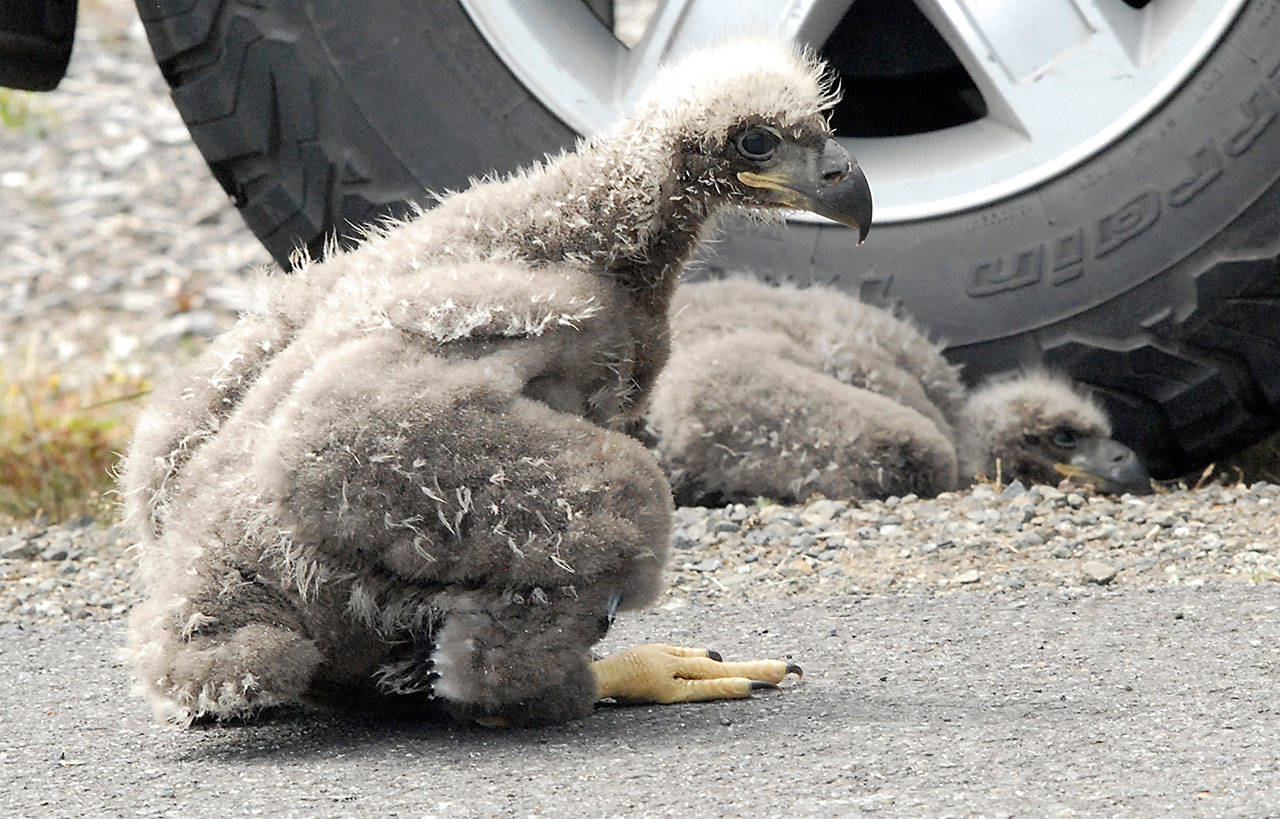Neighbors are keeping an eagle eye on a nest on Marine Drive in Sequim.
Two eaglets too young to fly were placed back into their nest overlooking Dungeness Bay last week, after they were discovered under a bush in a yard across the street from the tree in which the nest is lodged.
The babies apparently fell from the bald eagle nest high in the tree and Jaye Moore, the retired director of the Northwest Raptor Center in Sequim who “still dabbles” in animal rescue, worries that the baby birds will fall again.
“The nest was flat, not round,” said Moore who has decades of experience in animal rescues, many of injured eagles.
“They are going to need baby gates up to keep these kids in.”
Eagles build their nests in a bowl shape, but as the nests age they fill with feathers, bones and other debris, which eventually flattens out the well-used crib.
This one was confirmed to be an old, flat nest by the climber who replaced the eaglets in the nest, Moore said.
She had called Casey Balch, who owns the Pacific Northwest Tree Service, for help.
Usually eagles have alternate nests so that if one fills up then they can use another one.
“They are going to have to do some work on this one if they want to keep it,” Moore said.
And at this point, the adult eagles can’t move the chicks, which are only three to four weeks old, Moore said. Unlike animals that can carry their young in soft mouths, eagles have only talons. They can’t grip a baby or “they’d skewer him,” Moore said.
So the eaglets will remain in this nest until they leave at about 10-to-12-weeks-old, after maturing at about nine weeks.
At least Moore hopes they will remain in the nest.
“If they keep falling out, they are not going to survive,” she said.
Even now it is a mystery how the babies managed to get to the bush where they were found.
After falling from the nest, the birds had to walk uphill, cross a road, maneuver through a large patch of gravel and settle under a bush in a residential yard — and this at an age when they are not expected to be able to walk, Moore said.
Standing and walking are skills generally developed at about six weeks of age.
“I don’t understand how they made it that far,” she said.
The two birds, which are about one foot tall and are covered in pin feathers, were discovered by a man walking his dog at about 9 a.m. Thursday, May 23.
Andy Pitts’ dog sniffed out the eaglets in a yard next door to Pitts’ home, and Pitts immediately phoned Moore.
She arrived at about 10 a.m. and took the twosome to Greywolf Veterinary Hospital in Sequim where Dr. Brittany Rose examined them. Other than a few maggots in their ears, the babies were healthy and well-nourished, Moore said.
Since they were uninjured, Moore decided to put them back in the nest. That’s when she called on Balch and his climbing skills.
He managed to get the babies — apparently the only ones in the family — out of the duffel bag and back into the nest by about 3 p.m.
During the rescue, worried parents paid close attention, Moore said.
“They were close by,” she said. “They’d fly overhead — we’d have to duck. They were watching.
“They were really concerned, as I would be if they were my kids.”
Since the eaglets were returned to the nest, they haven’t been seen, Moore said Friday.
“Mom and Dad have been in and out, but we haven’t seen the babies,” Moore said. “I’m hoping and praying that they are still there.”
Pitts, the man who found the eaglets, shares her concern.
“He’s been keeping an eye on the nest,” Moore said, in case another rescue is needed.



